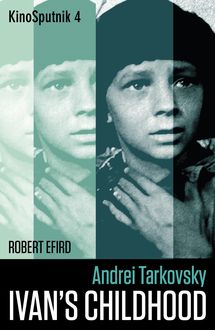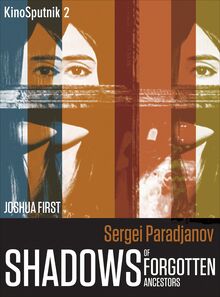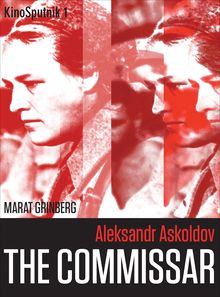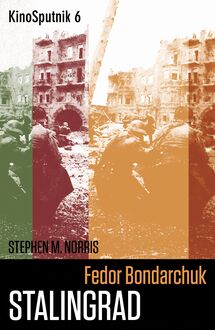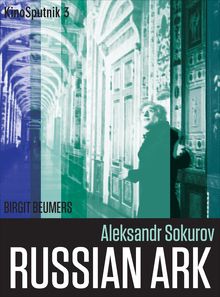-
 Univers
Univers
-
 Ebooks
Ebooks
-
 Livres audio
Livres audio
-
 Presse
Presse
-
 Podcasts
Podcasts
-
 BD
BD
-
 Documents
Documents
-
- Cours
- Révisions
- Ressources pédagogiques
- Sciences de l’éducation
- Manuels scolaires
- Langues
- Travaux de classe
- Annales de BEP
- Etudes supérieures
- Maternelle et primaire
- Fiches de lecture
- Orientation scolaire
- Méthodologie
- Corrigés de devoir
- Annales d’examens et concours
- Annales du bac
- Annales du brevet
- Rapports de stage
La lecture à portée de main
Vous pourrez modifier la taille du texte de cet ouvrage
Découvre YouScribe en t'inscrivant gratuitement
Je m'inscrisDécouvre YouScribe en t'inscrivant gratuitement
Je m'inscrisEn savoir plus
Vous pourrez modifier la taille du texte de cet ouvrage
En savoir plus

Description
KinoSputniks closely analyse some key films from the history of Russian and Soviet cinema. Written by international experts in the field, they are intended for film enthusiasts and students, combining scholarship with an accessible style of writing.
This KinoSputnik about Fedor Bondarchuk's megahit Stalingrad (2013) examines the production, context and reception of the film, whilst offering a detailed reading of its key themes.
Fedor Bondarchuk’s 2013 blockbuster film Stalingrad shattered box-office records and dazzled viewers with its use of special effects, enhanced by its 3D IMAX format. The film transported viewers back to 1942 and the bloody battle that would turn the tide of the Second World War.
This new study situates the film within the context of ongoing debates about the meanings of the Second World War in Russia and previous films about the Battle of Stalingrad.
Primary readership will be among film studies students and film enthusiasts, but will also be of interest to anyone researching or studying the Battle of Stalingrad and the course of the Second World War.
A list of all books in the series is here on the Intellect website on the series page KinoSputnik
List of Illustrations vii
Note on Transliteration xi
Production Information xiii
Plot Summary xv
1. Production History and Historical Context: Stalingrad as Memory Battleground 1
2. Cinematic Context: Battle of Stalingrad (1949), They Fought for the Motherland (1975) and Stalingrad (1989) 29
3. Film Analysis: Stalingrad Onscreen 67
4. Reacting to Stalingrad 121
Conclusion 163
Notes 167
References 17
Sujets
Informations
| Publié par | Intellect Books |
| Date de parution | 01 juin 2022 |
| Nombre de lectures | 0 |
| EAN13 | 9781789384826 |
| Langue | English |
| Poids de l'ouvrage | 2 Mo |
Informations légales : prix de location à la page 0,1250€. Cette information est donnée uniquement à titre indicatif conformément à la législation en vigueur.
Extrait
Fedor Bondarchuk:
Stalingrad
KinoSputnik 6
Fedor Bondarchuk:
Stalingrad
By Stephen M. Norris
First published in the UK in 2022 by
Intellect, The Mill, Parnall Road, Fishponds, Bristol, BS16 3JG, UK
First published in the USA in 2022 by
Intellect, The University of Chicago Press, 1427 E. 60th Street, Chicago, IL 60637, USA
Copyright 2022 Intellect Ltd
All rights reserved. No part of this publication may be reproduced, stored in a retrieval system, or transmitted, in any form or by any means, electronic, mechanical, photocopying, recording, or otherwise, without written permission.
A catalogue record for this book is available from the British Library.
Copy editor: MPS Limited
Cover designer: Aleksandra Szumlas
Production manager: Sophia Munyengeterwa
Typesetter: MPS Limited
Print ISBN: 978-1-78938-480-2
ePDF ISBN: 978-1-78938-481-9
ePUB ISBN: 978-1-78938-482-6
Part of the KinoSputniks series ISSN 2059-5069 | Online ISSN 2059-5077
Printed and bound by CMP
To find out about all our publications, please visit
www.intellectbooks.com
There you can subscribe to our e-newsletter, browse or download our current catalogue and buy any titles that are in print.
This is a peer-reviewed publication.
Contents
List of Illustrations
Note on Transliteration
Production Information
Plot Summary
1 Production History and Historical Context: Stalingrad as Memory Battleground
2 Cinematic Context: Battle of Stalingrad (1949), They Fought for the Motherland (1975) and Stalingrad (1989)
3 Film Analysis: Stalingrad Onscreen
4 Reacting to Stalingrad
Conclusion
Notes
References
Illustrations
Figure 1.1. Boris Efimov, ‘Berlin Jubilee’. Pravda 1 February 1943.
Figure 1.2. Pavlov's House in 1943. Wikimedia Commons.
Figure 1.3. Pavlov's House memorialized, the remaining wall bears the two mythic narratives, one associated with its defenders during the battle and the other with the women who rebuilt after the war. WikimediaCommons.
Figure 2.1. Stalin's Genius. Stalin (Aleksei Dikii) schools General Chuikov on street fighting in Stalingrad. Still from Vladimir Petrov's The Battle of Stalingrad (1949).
Figure 2.2. Pavlov's House. Still from Petrov's The Battle of Stalingrad .
Figure 2.3. Red Army soldiers celebrate victory at Stalingrad. Still from Petrov's The Battle of Stalingrad .
Figure 2.4. ‘They’: the grizzled, human soldiers of Sergei Bondarchuk's They Fought for Their Motherland .
Figure 2.5. ‘Fought’: the heroes dig in and fight in Sergei Bondarchuk's They Fought for Their Motherland .
Figure 2.6. ‘Motherland’: the villages our heroes protect in Sergei Bondarchuk's They Fought for Their Motherland .
Figure 2.7. Suspicious Stalin. Still from Iurii Ozerov's Stalingrad (1989).
Figure 2.8. A Heroic Private Ivan (Fedor Bondarchuk). Still from Iurii Ozerov's Stalingrad (1989).
Figure 2.9. Pavlov (Sergei Garmash) in front of his House. Still from Iurii Ozerov's Stalingrad (1989).
Figure 3.1. Chvanov, Katia, Gromov, Astakhov and Nikiforov in the House. Still from Fedor Bondarchuk's Stalingrad (2013).
Figure 3.2. Kahn and Masha. Still from Fedor Bondarchuk's Stalingrad (2013).
Figure 3.3. Katia's birthday party; Nikiforov sings and Chvanov, Gromov, Sergei and Poliakov listen. Still from Fedor Bondarchuk's Stalingrad (2013).
Figure 3.4. Georgii Zelma, ‘Soviet forces fire from the windows of a destroyed house in Stalingrad’, 1942. Multimedia Art Museum Moscow (MAMM) (Moskovskii Dom Fotografii [MDF]).
Figure 3.5. Gromov's men fire from the windows of the destroyed house in Stalingrad . Still from Fedor Bondarchuk's Stalingrad (2013).
Figure 3.6. Viktor Temin, Stalingrad on Fire , 1942. MAMM (MDF).
Figure 3.7. Our first look at Stalingrad in Bondarchuk's Stalingrad . Soldiers are making the dangerous Volga crossing. In the background, the city is aflame. Still from Fedor Bondarchuk's Stalingrad (2013).
Figure 3.8. Georgii Zelma, The House is Taken , 1942. MAMM (MDF).
Figure 3.9. The House is not taken, Gromov's men defend the House again. Still from Fedor Bondarchuk's Stalingrad (2013).
Figure 3.10. Georgii Zelma, The Battle for Pavlov's House , September–November 1942. MAMM (MDF).
Figure 3.11. Nikiforov defends the House. Still from Fedor Bondarchuk's Stalingrad (2013).
Figure 3.12. German troops attack Pavlov's House. Still from Fedor Bondarchuk's Stalingrad (2013).
Figure 3.13. Emmanuel Evzerikhin, The Fountain ‘Children's Dance ’, 23 August 1942. MAMM (MDF).
Figure 3.14. The Fountain Statue. Still from Fedor Bondarchuk's Stalingrad (2013).
Note on Transliteration
The Library of Congress system (ALA-LC) has been used throughout. Exceptions are made for German names in the film, and when Russian names have an accepted English spelling (e.g. Yeltsin).
Production Information
Production credits
Title: Stalingrad (Russia, 2013)
Details: Colour, 131 minutes
Genre: War film
Languages: Russian, German and Japanese
Director: Fedor Bondarchuk
Screenplay: Il'ia Til'kin and Sergei Snezhkin, adapted from Vasilii Grossman s novel
Cinematography: Maksim Osadchii
Music: Angelo Badalamenti
Production design: Sergei Ivanov
Costume designer: Tat'iana Patrakhal'tseva
Set: Elena Dunaeva, Oleg Bulakhov and Polina Gavrilova
Editing: Igor' Litoninskii
Producers: Aleksandr Rodnianskii, Dmitrii Rudovskii,Sergei Mel'kumov, Anton Zlatopol'skii and Natal'ia Kotkova
3D producer: Steve Schklair
Executive producers: Natal'ia Gorina and Michael Schlicht
Production: Art Pictures Group and Non-Stop Production
Budget: USD 30 mill.
Box Office: USD 51,760,472 (Russia); USD 68,129,518 (world)
Premiere: 10 October 2013
Cast
Katia: Mariia Smol'nikova
Masha: Ianina Studilina
Captain Gromov: Petr Fedorov
Captain Peter Kahn: Thomas Kretschmann
Sergei: Sergei Bondarchuk
Poliakov: Andrei Smoliakov
Aleksandr Nikiforov: Aleksei Barabash
Chvanov: Dmitrii Lysenkov
Romanov: Oleg Volku
Henze: Heiner Lauterbach
Natashka: Polina Raikina
Nina: Anna von Abler
J rgens: Petar Zekavitsa
Mitia: Dmitrii Kochkin
Klose: Georges Devdariani
Gottfried: Philippe Reinhardt
Otto: Christoph Gawenda
Tomka: Oksana Bazilevich
Raia: Svetlana Svirko
Plot Summary
Stalingrad has two overlapping plotlines, bookended by scenes in Japan during the aftermath of the 2011 earthquake there, where a Russian man named Sergei is involved in the rescue efforts. The first is set in an apartment building, a version of the mythic Pavlov s House, and concerns the last remaining resident, 18-year-old Katia, who has refused to leave her home. She interacts with five soldiers defending the building: the voiceover tells us early on that Katia will have a child from one of these soldiers but that she considers all of them her son s five fathers . The men embody different types who came to the city to defend it. Gromov, the Captain, is a hero who has witnessed too much death already but who is steadfast in preserving his honour as a professional soldier. Poliakov is older than the Captain, nicknamed Angel , and has preserved his religious beliefs. Sasha Nikiforov, the third, has been shaped by the war and desires nothing more than to kill the enemy. The two youngest are Chvanov, a villager who is also a sharpshooter-turned-sniper who witnessed the Germans murder his younger brother; and Sergei Astakhov (played by Bondarchuk s son), who is nicknamed sissy because he failed in an earlier mission. The five bond through their shared love for Katia: they celebrate her birthday and come to see their fight as one not for the Motherland or Stalin, but for her. All five die, but not before impregnating their heroism into Katia and her son: the biological father, as the film eventually reveals, is Sergei. The son, we learn from the beginning and end scenes, is the Sergei who volunteers to help victims of the 2011 earthquake in Japan, thus suggesting that the heroism of Stalingrad s defenders survived and was passed down to the next generation.
The second plotline concerns their German enemies, particularly Captain Peter Kahn (played by Thomas Kretschmann), who has been ruined by the war. He has raped a Russian woman, Masha, but also protects her from other traumas. Kahn tells Masha that she - and by extension, all Soviet citizens - have turned him into a beast while he just claims to be simply a soldier . Kahn promises he will protect Masha once the battle is won; Chvanov ultimately kills her for being a collaborator. With the exception of a stereotypical colonel who is characterized as a timeless beast, most of the German soldiers are depicted as human counterparts to the Soviets, albeit less heroic.
What draws these plotlines together - and what makes Stalingrad a significant film - is the recreation of the ruined city, the hand-to-hand combat that took place in it, and the look of warfare on the Eastern Front of Second World War. Employing state-of-the-art CGI and using the IMAX 3D format, the film brings viewers into the experience of 1942 Stalingrad.
1 Production History and Historical Context: Stalingrad as Memory Battleground
Fedor Bondarchuk s film Stalingrad (2013), as its massive PR campaign routinely noted, was the first Russian film made in 3D IMAX. Bondarchuk s film had an enormous budget (by Russian standards) of USD 30 million, including a federal subsidy of USD 10 million. It set box office records when released, grossing over USD 57 million in Russia and USD 68 million worldwide. It did unexpectedly well in China, becoming the first Russian film to lead the weekend box office in that country. It also had a limited release in the United States, where it did not make the hoped-for impact but still managed to receive quite a number of reviews for a foreign film. Stalingrad s significance in part rests on these firsts : the first Russian film shot in a format associated more with Hollywood, the highest-grossing domestic film in Russian history (it ha
-
 Univers
Univers
-
 Ebooks
Ebooks
-
 Livres audio
Livres audio
-
 Presse
Presse
-
 Podcasts
Podcasts
-
 BD
BD
-
 Documents
Documents
-
Jeunesse
-
Littérature
-
Ressources professionnelles
-
Santé et bien-être
-
Savoirs
-
Education
-
Loisirs et hobbies
-
Art, musique et cinéma
-
Actualité et débat de société
-
Jeunesse
-
Littérature
-
Ressources professionnelles
-
Santé et bien-être
-
Savoirs
-
Education
-
Loisirs et hobbies
-
Art, musique et cinéma
-
Actualité et débat de société
-
Actualités
-
Lifestyle
-
Presse jeunesse
-
Presse professionnelle
-
Pratique
-
Presse sportive
-
Presse internationale
-
Culture & Médias
-
Action et Aventures
-
Science-fiction et Fantasy
-
Société
-
Jeunesse
-
Littérature
-
Ressources professionnelles
-
Santé et bien-être
-
Savoirs
-
Education
-
Loisirs et hobbies
-
Art, musique et cinéma
-
Actualité et débat de société
- Cours
- Révisions
- Ressources pédagogiques
- Sciences de l’éducation
- Manuels scolaires
- Langues
- Travaux de classe
- Annales de BEP
- Etudes supérieures
- Maternelle et primaire
- Fiches de lecture
- Orientation scolaire
- Méthodologie
- Corrigés de devoir
- Annales d’examens et concours
- Annales du bac
- Annales du brevet
- Rapports de stage
